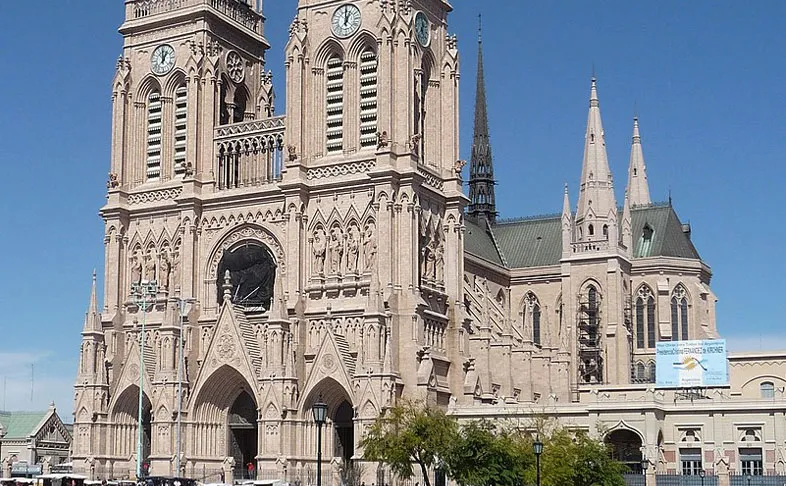Introduction
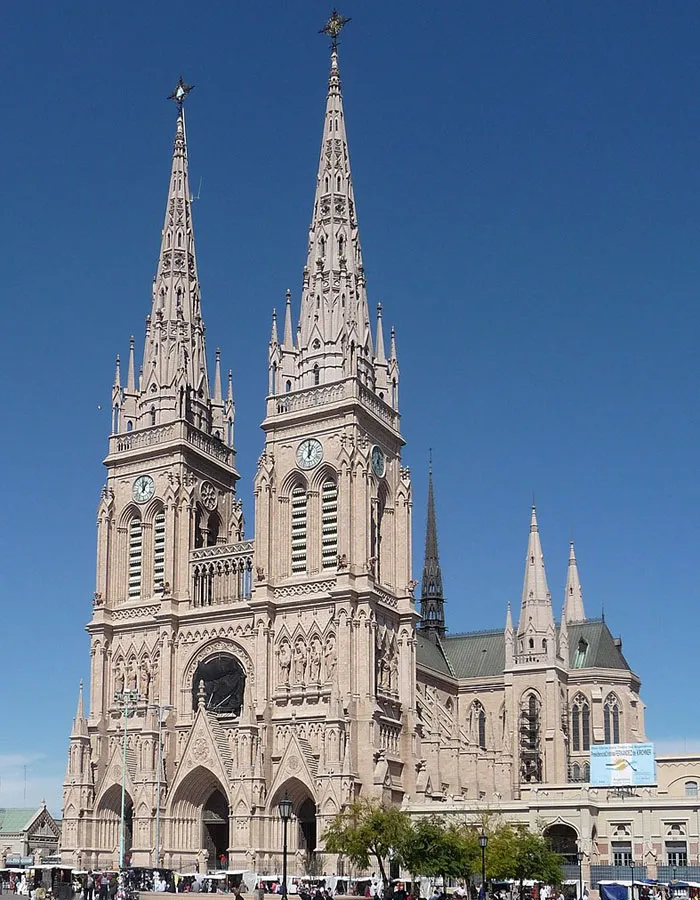
The Minor Basilica of Our Lady of Luján / Basilica of Our Lady of Luján, Argentina (Spanish: Basílica Menor de Nuestra Señora de Luján) is a Roman Catholic church building in Luján, Buenos Aires, Argentina. Built in Neogothic style, it is dedicated to Our Lady of Luján, patron saint of Argentina.
Many people mistake this temple for a cathedral. Actually, it is part of the Roman Catholic Archdiocese of Mercedes-Luján, whose see is located at the Cathedral Basilica of Mercedes-Luján in the neighboring city of Mercedes.
Forty three miles (68 km) west of Buenos Aires, the capital of Argentina, stands the city of Luján, famous for its great basilica dedicated to Mary, Our Lady of Luján. Called Nuestra Señora de Luján in Spanish, its construction was begun in 1887 and completed 48 years later in 1935. Our Lady of Luján is considered the Patroness of Argentina, Paraguay and Uruguay.
In 1930 Pope Pius XII gave the sanctuary the title of Basilica and it was declared a National and Historical Monument in 1998. (The second statue, depicting Mary holding the child Jesus, reached its destination and is today worshiped under the title of Our Lady of Consolation.)
While Fr. Buela, founder, was still a seminarian he made a pilgrimage to the Basilica of Our Lady of Luján and prayed to her for an abundance of priestly and religious vocations to the Church. From the beginning of our Religious Family, we have always considered that the gift of our vocations comes from God through her hands.
On March 7, 1984 we fulfilled a vow made to Our Lady of Luján in thanksgiving for the possibility of being able to begin with our experience of religious life. This St. Louis Marie Grignion de Montfort medallion was made by Amado Armas as a token of thanksgiving for the beginning of our religious family; found in the first chapel of the right ambulatory next to the camarin of the Virgin in the Basilica of Luján.
At the close of 1988 the first group of sisters traveled from San Rafael to the province of Buenos Aires and made a pilgrimage to Our Lady of Luján. There they made their first vows of Marian slavery and consecrated our new institute to the Blessed Virgin.
History of Basilica of Our Lady of Luján, Argentina
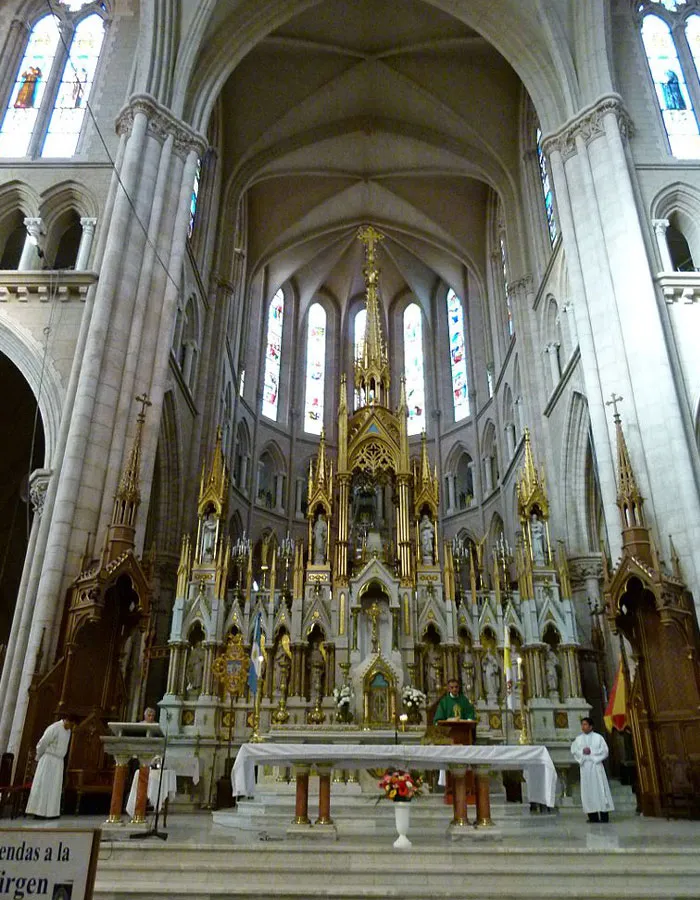
Lujan today is a great religious center, with many churches. Soon after the first church had been completed, it proved insufficient to provide for the pilgrims who came from all over the vast country. Many recorded miracles occurred, and various Kings of Spain (Argentina was then a colony of Spain) bestowed upon the shrine gifts and jewels as ornate as those donated to the oldest and most famous ones in Europe.
Argentina has many other holy places dedicated to the Virgin, but Lujan is the most outstanding. Several religious orders, the Carmelites, the Dominicans, the Jesuits, the Franciscans and others have established churches and monasteries around the shrine, which now is in the custody of the Lazarists.
In 1904, the image was placed in the new cathedral, while it was still under construction. The cathedral was completed and consecrated in 1910. It is one of the most important in the world and can best be compared with the gigantic Spanish cathedrals.
The tiny figure of the Madonna, with her wide open blue eyes, surrounded by a golden aureole, clothed in heavy, shining robes and crowned with a gem which has over 350 diamonds, sapphires, rubies and about 130 pearls, looks into the distance.
Everything about her is of a corresponding grandeur. Both the material wealth of a country and the vigorous faith of its people here give expression to the spirit of the New World. By the end of the eighteenth century Lujan became the most important national pilgrimage site in Argentina. During the fight for independence, she became the symbol of victory and the captured flags were placed in the sanctuary.
General San Martin, who passed through the Andes with his army following his successful campaign, laid his sword down forever in the cathedral in honor of Our Lady of Lujan. In 1930, on the occasion of the three hundredth anniversary of the foundation of the sanctuary, the church housing the image was elevated to the rank of a Basilica. At the same time, Argentina, Uruguay and Paraguay recognized Our Lady of Lujan as their protectress.
Recently the Argentine Army chose the Virgin of Lujan as its patroness. And according to an old custom a regiment of the army was dedicated to her services. This regiment becomes her “property” and the members of the regiment call her “La generala del Lujan.”
Architecture of Basilica of Our Lady of Luján, Argentina
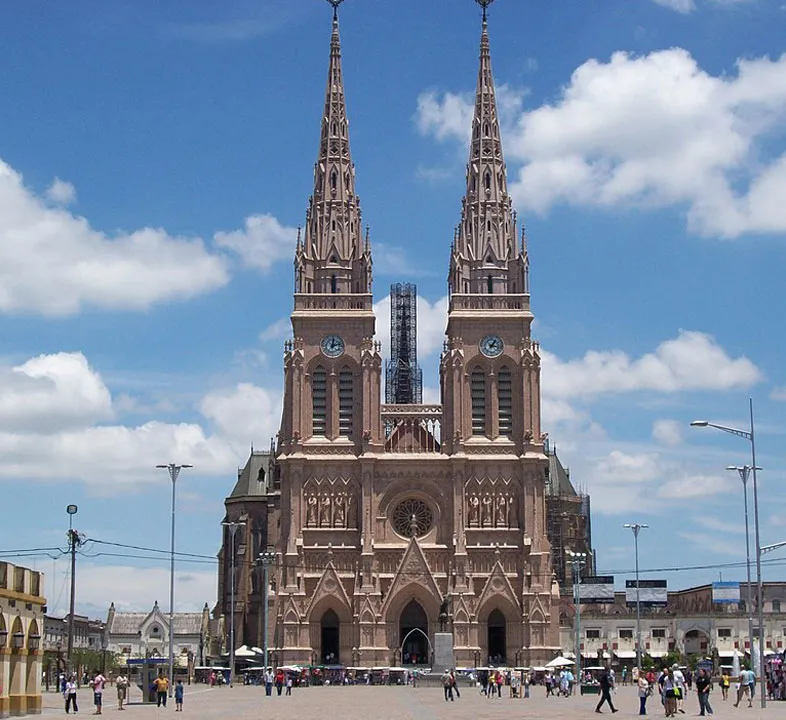
Basilica of Our Lady of Luján, Argentina – The two main towers of the Basilica are 106 meters tall and the interior is done in a French Gothic style, with beautiful stained glass windows. The terracotta statue of the Virgin is only two feet high (38 cm) and has a pure gold crown, which is set with 365 diamonds, rubies, emeralds and sapphires, 132 pearls and a number of enamels depicting the emblems of the Archbishop and the Argentine Republic.
In 1887, in order to prevent its decay, the statue was given a solid silver covering. It is normally clothed with a white robe and sky blue cloak, these being the colors of the Argentine flag. The papal coronation of Our Lady of Luján, by Pope Leo XII, took place on May 8, 1887.
Approximately six million people visit the Basilica of Our Lady of Luján, Argentina each year, many of them coming during four major pilgrimage periods. One of these, the Peregrinación de los Gauchos (Gaucho´s Pilgrimage), takes place on the last Sunday of September and is considered to be one of the most picturesque cultural events in Argentina. Gauchos are the cowboys of Argentina’s vast grasslands and during the pilgrimage it is common to see their horses waiting outside of the church.
A week or so later, on the first Sunday in October, is the Peregrinación de los Jóvenes (Pilgrimage of the Young), when around a million youths walk the whole 68 kilometers from Buenos Aires to the Basilica in a display of faith and gratefulness. The feast days of Nuestra Señora de Luján are celebrated on May 8 and December 8, and during these times nautical pilgrimages take place in the Luján River, with statues of the Virgin aboard a boat.
Our Lady of Luján (The Virgin of Luján)
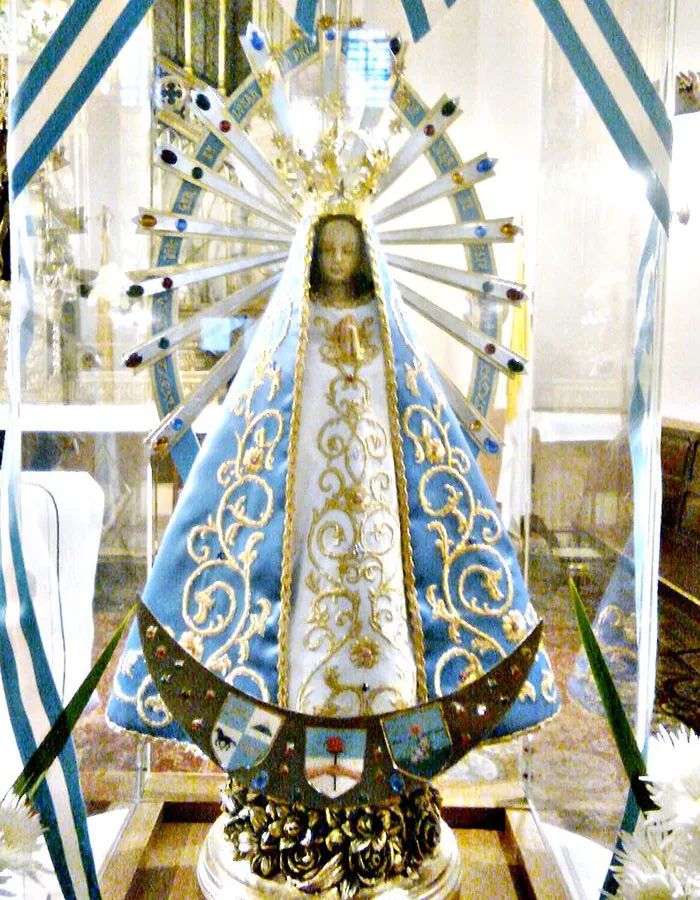
Our Lady of Luján (Spanish: Nuestra Señora de Luján) is a celebrated 16th-century statue of the Virgin Mary, mother of Jesus Christ. The image, also known as the Virgin of Luján (Spanish: Virgen de Luján), is on display in the Basilica of Luján in Argentina.
Our Lady of Luján is the special patroness of our Religious Family and her image accompanies us in all our foreign missions. Every year our Religious Family honors Our Lady of Luján on May 8, her feast day, with Novenas, Solemn Masses and the Marian Consecration of our new Novices. Through the intercession of Our Lady of Luján may our Religious Family always receive many holy vocations—generous souls who seek only to give glory to God and to work tirelessly for the salvation of souls in every land.
The figure of our Lady of Lujan is made of terracotta and was covered in silver in the late 1800s (to protect the figure). Her blue eyes open and her hands folded in prayer, she wears a white robe and blue cloak, which are the colors of the Argentine Flag. The robe and cloak are decorated with flowers and vines, and she wears a golden crown.
The statue was transferred to the nearby home of Don Rosendo Oramas, who built a rustic chapel for it. In 1763, the statue was moved to a larger shrine in the city of Luján.
Work on a large Basilica reached its completion in 1904 when the image of Our Lady of Luján was solemnly transferred there. Every October large crowds of youth walk the 40 miles from Buenos Aires to Luján in an overnight pilgrimage of great Marian devotion.
During the period of independence in the late 18th and early 19th century, the flag of the free Argentina was designed by Sargent Major Carlos Belgrano to reflect the “blue and white of the Immaculata of Luján.” She has always been invoked as the patroness of all the regions of La Plata: Paraguay, Uraguay and Argentina.
History of Our Lady of Luján
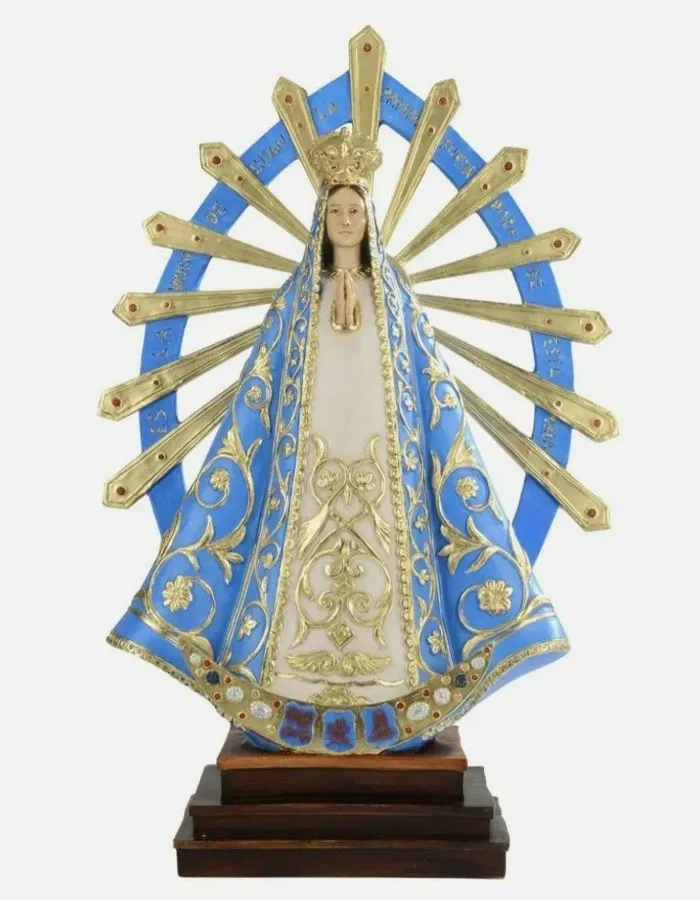
The history of the shrine begins in 1630, with a farmer who came to Argentina from Portugal. He came from a place where the Catholic Faith was strong, but he was sad when he came to live in the village of Sumampa, Argentina.
Here the Catholic Faith was very weak and there was no shrine to Our Lady. The farmer decided to build a little chapel on his land in the village, and he wrote to his friend in Brazil, asking him to send a small statue of Our Lady. The friend was not sure what the farmer wanted the statue of the Blessed Virgin to look like, so he sent two statues – one statue of Our Lady was holding the Child Jesus and the other statue was the Immaculate Conception.
The statues were shipped by sea at first and then they were placed on a cart for the journey inland. Because the natives in the area were a fighting bunch, a number of carts and pack horses banded together in a caravan. When it became dark, they camped at the ranch of Don Rosendo de Oramus.
Early the next morning, the carts began to set off one by one, all except the cart that carried the statues of the Blessed Virgin Mary; the driver was unable to get the horses to move the cart! Other men came to help, but all in vain – neither the animals nor the cart would move! Only when the statue of the Immaculate Conception was removed from the cart, did the horse start pulling. The statue of Our Lady with the Child Jesus continued its journey and arrived safely in Sumampa, where it is still venerated today.
Now the story takes another turn. An eight year old African slave boy, named Manuel, who was traveling with the caravan, stood in awe when the animals would not move. When the statue of the Immaculate Conception was removed, he begged to remain at Don Rosendo’s Ranch, as a servant to Our Lady.
Don Rosendo made arrangements with Manuel’s owner, and kept him at the ranch. Here the statue was enshrined and here Manuel worked as a sacristan for many years, amazing everyone by his charity and piety. As he grew, he devoted his time to the care of the sick, the poor and those in need.
When Don Rosendo died in 1670, a pious lady named, Dona Ana de Mattos, obtained permission to move the shrine from Don Rosendo’s Ranch to a chapel on her own property, some fifteen miles away. The ranch was too much out of the way and it was in constant danger of Indian attack! Even so, Manuel was left behind to care for the property.
When the statue of the Immaculate Conception arrived at the home of Dona Ana, it was taken to the chapel and enshrined there. Following prayers of welcome to Our Lady, the shrine was locked up tight for the night. But the next morning, it was discovered that the statue of Our Lady had disappeared! When some men went in search of the statue of Our Lady, they found it at Don Rosendo’s Ranch, in the chapel on the pedestal, where it had always stood.
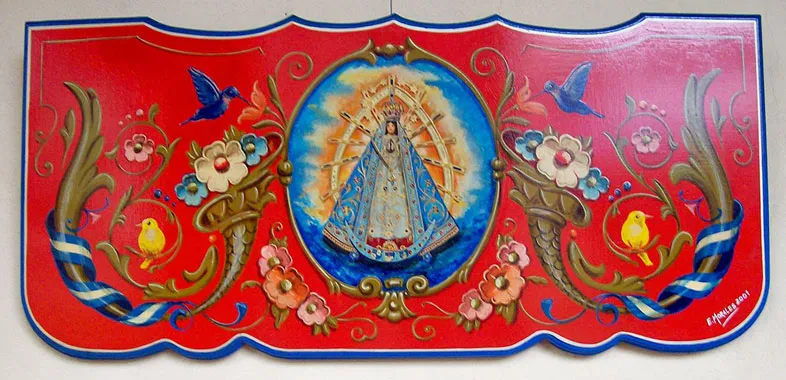
Once more the statue of Our Lady was carried to Dona Ana’s chapel. But this time, in addition to locking the doors of the chapel, a guard was placed to keep watch. And again, the statue of Our Lady disappeared and was found in the chapel at Don Rosendo’s Ranch!
At first, Manuel was blamed for taking the statue of Our Lady back to the ranch, but later it was proved that there was no way he could have got into Dona Ana’s locked chapel and taken the statue of Our Lady! Dona Ana then asked the Bishop and the Governor of the Province what she should do.
They decided to carry the statue of Our Lady in solemn procession form Don Rosendo’s Ranch to Dona Ana’s chapel. This time Manuel went with the statue in procession to Dona Ana’s and from then on Manuel remained as the caretaker for his beloved statue of Our Lady. Now that Our Lady had her favourite sacristan with her, she remained in her new location.
The new shrine became so popular that it soon had to be enlarged. The foundation stone for the new church was laid in 1677, by Fra Gabriel, a Carmelite Friar. It was during this year that the first recorded miracle took place. Other miracles had taken place before this date, but they had not been carefully written down.
Our Lady told Manuel when he was going to die and promised him that he would go to Heaven. Manuel died a holy death on the date Our Lady had promised and he was buried in a tomb at the foot of the altar, where the miraculous statue of Our Lady was enshrined. In 1710, another recorded miracle took place. Fr. Bernabe had a tumour in his throat. He rubbed some oil from the lamp at Our Lady’s shrine on his throat, and was cured.
The pilgrims increased in number, and a church which was started in 1730, was soon abandoned in favour of another church built in 1763. This was the year Our Lady of Lujan was declared patroness of Buenos Aires. For the next hundred years, several different orders of priests laboured at the shrine and the shrine gradually became famous throughout the world.
Another great miracle occurred on August 28, 1780. On that date, news arrived at the shrine that a large group of Indians were killing all the people in their path, as they advanced ever closer to Lujan! People panicked when they heard the news and they fled to the shrine, begging Our Lady to protect them. Suddenly, while they were praying, a mysterious thick fog gathered quickly throughout the town, completely hiding it from the enemy.
The warring Indians lost their way and travelled elsewhere. And the faithful pilgrims, who prayed to Our Lady of Lujan, believed that she had saved them. Another time when parts of Argentina were afflicted with cholera, the Archbishop vowed to make a pilgrimage to Lujan if his Archdiocese was spared. Then while other cities suffered, Buenos Aires, both city and province, and Lujan, were spared from the terrible cholera sickness. Our Lady had heard their prayers again!
Papal Honors
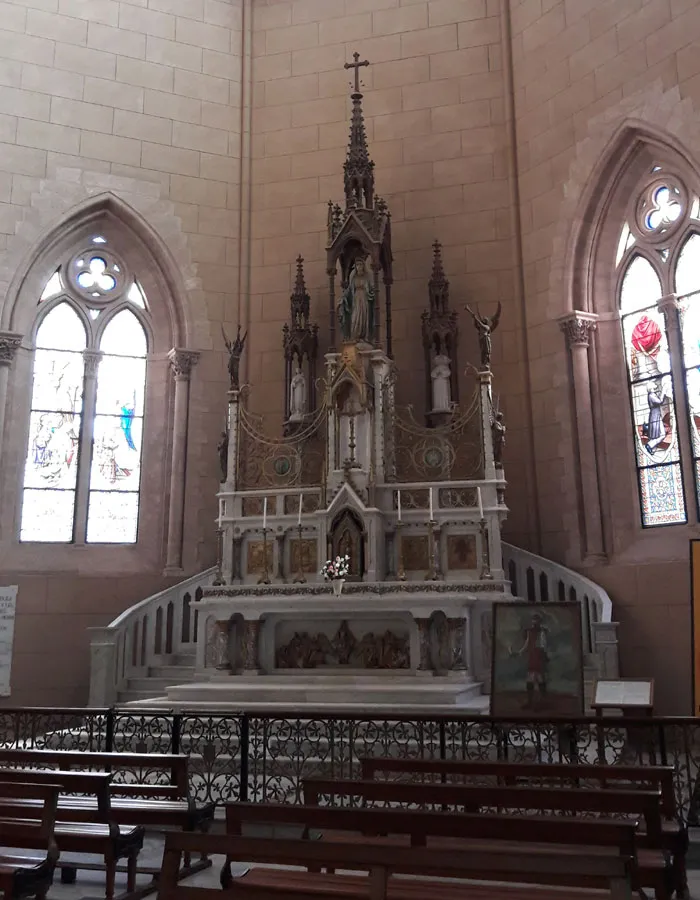
Among the Popes who have honored Our Lady of Luján are Clement XI, Clement XIV, Pius VI, Pius IX, Leo XIII, Pius XI, Pius XII, and John Paul II. In 1824, Fr. John Mastai Ferretti visited the shrine on his way to Chile. He later became Pope Pius IX and defined the dogma of the Immaculate Conception on December 8, 1854.
Because of the reputation of the shrine, Pope Leo XIII decided in 1886 to honor the miraculous statue with a Canonical Coronation. On September 30 of that year, he blessed the crown, which was made of pure gold and set with 365 diamonds, rubies, emeralds and sapphires, 132 pearls and a number of enamels depicting the emblems of the Archbishop and the Argentine Republic.
The papal coronation of Our Lady of Luján took place on May 8, 1887. The celebrant chosen by the Pope for this event was Archbishop Federico León Aneiros who at that time made a pilgrimage in thanksgiving to Our Lady for sparing his archdiocese from the scourge of cholera.
On 8 September 1930, Pope Pius XI formally declared Our Lady of Lujan as the Patroness of Argentina, Paraguay and Uruguay. The Papal document was signed by Cardinal Eugenio Pacelli, the future Pope Pius XII.
Cardinal Eugenio Pacelli served as the Papal Legate to the XXXII International Eucharistic Congress held in Buenos Aires in October 1934, and visited the Basilica on October 15. When he became Pope Pius XII, he made a radio address to the pilgrims in Luján on the occasion of the First Marian Congress in Argentina in 1947.
In 1982, during the Falklands War, John Paul II became the first pope to visit Our Lady of Luján. During this visit the Pope celebrated an outdoor Mass in the square of the Basilica of Our Lady of Luján and bestowed upon her the Golden Rose. Both in his homily of June 11 and his Angelus back in Rome reflecting on the trip, he commented on Our Lady’s never failing maternal solicitude for the faithful in times of distress. Sixteen years later in Rome, John Paul II gave a replica of the image to the Argentine National Parish during his pastoral visit there.
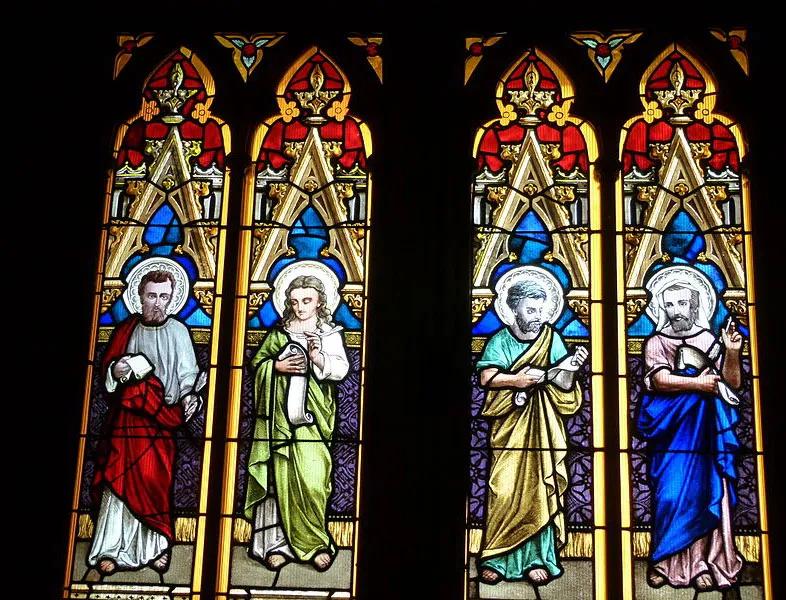
The Golden Rose
The Golden Rose is a gift from the Pope to nations, cities, basilicas, sanctuaries, or images. It is blessed by him on the fourth Sunday of Lent, anointed with the Holy Chrism, and dusted with incense. This Rose consists of a golden rose stem with flowers, buds and leaves, placed in a silver vase lined on the inside with a bronze case bearing the Papal shield. Pope Leo IX is considered as the originator of this tradition in the year 1049.
In the Americas, the Rose has been given to Our Lady of Guadalupe in Mexico, to Our Lady of Aparecida in Brazil, to St. Joseph’s Oratory in Canada, to the Basilica of the National Shrine of the Immaculate Conception in the United States, to the Cathedral Basilica of Nuestra Señora del Valle in Argentina and to the Basílica Santuario Nacional de Nuestra Señora de la Caridad del Cobre in Cuba. On June 11, 1982, John Paul II personally bestowed a Golden Rose on Our Lady of Luján.
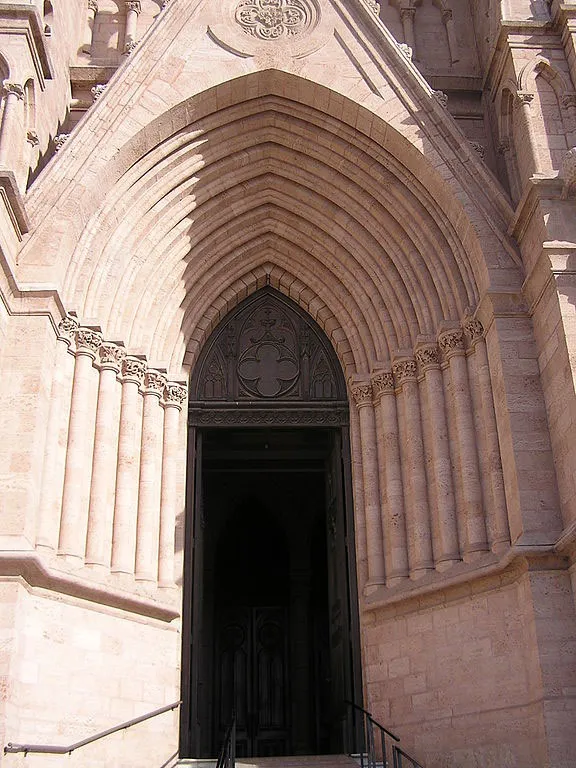
Feast Day - 8th May
Annual Feast Day of Our Lady of Luján is held on 8th May.
Mass Time
Weekdays
- 8:00 am
- 11:00 am
- 3:00 pm
- 5:00 pm
- 7:00 pm
Sundays
- 8:00 am
- 9:30 am
- 11:00 am
- 1:00 pm
- 3:00 pm
- 5:00 pm
- 7:00 pm
Church Visiting Time
- Every Days : 8:00 am to 8:00 pm
Contact Info
San Martín 51, Luján,
Provincia de Buenos Aires, Argentina.
Phone No.
Tel : +54 2323 42-0058
Accommodations
How to reach the Basilica
El Palomar Airport in Argentina is the nearby Airport to the Basilica.
Luján Train Station in Luján, Argentina is the nearby Train Station to the Basilica.

